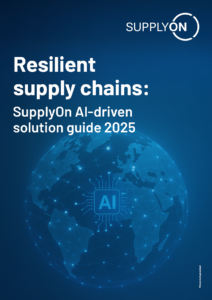Purchasing processes via SupplyOn Sourcing: As simple as possible, as complex as needed
![]()
How effective is a sourcing tool that, while it basically covers all conceivable purchasing processes, is so complicated that not all buyers use it, since it requires too much training or because even trained buyers soon forget how to operate it?
The company-wide adoption of a sourcing tool is the only effective way to standardize purchasing processes, adhere to purchasing compliance guidelines and improve the overall efficiency of a purchasing organization. Therefore, SupplyOn’s motto is: as simple as possible, as complex as needed.
This principle is clearly demonstrated by a global plant construction company which has found a tool that covers precisely the required functions in the SupplyOn solution and is reaping the rewards as it is rolled out globally.
Sourcing: Challenges facing a global purchasing organization
This global plant construction company wanted to standardize and optimize its purchasing processes group-wide by introducing a sourcing tool. The target processes were defined by the headquarters, with the intention of rolling them out across the company’s global purchasing organization. The aim was to handle all request processes (Requests for Information, Proposal and Quotation) via a central system in order to ultimately increase the efficiency and transparency of the purchasing organization.
Various different sourcing tools were tested; failed, however, to deliver the desired result for two main reasons: The handling was so complicated, that many buyers could not and did not want to use them. Additionally, important functions were missing, thus prohibiting the proper representation of complex requests. For example, it was not possible to add files larger than 10 MB or upload a request with various items as an Excel table.
However, both aspects are essential in the field of plant construction, as the majority of requested parts are complex and accompanied by extensive diagrams and bills of material. While a back-end integration was theoretically feasible, the company decided against it, as this would have involved a great amount of effort. As a result, merely a handful of employees would have used the tool. Hence, the aim of having group-wide standardized purchasing processes would not have been achieved.
The SupplyOn Sourcing solution
In keeping with the motto “as simple as possible, as complex as needed”, requests for quotations on SupplyOn Sourcing are reduced to the essentials, concise and easily generated. Individual templates can be provided for different types of requests with relative ease, for example a template with a simple structure for requests of indirect materials or a template with a bill of material structure for requests of production materials. The templates are clear, yet contain all the fields required for the respective type of request.
In addition, there are virtually no restrictions in terms of file attachments, therefore even very comprehensive construction plans can be attached to requests. Bills of material and other such documents can be easily uploaded from an Excel file.
The back-end integration option further simplifies the buyers’ work, as master data and documents can be automatically imported from internal systems. Back-end integration is highly attractive for the plant construction company, because a large proportion of the requested components are drawing-based and customer-specific.
A one-month Proof of Concept phase was followed by a three-day workshop in which SupplyOn and select buyers developed three templates for the request types “Direct Materials”, “Indirect Materials” and “Transport Services”, thereby incorporating process expertise and knowledge pertaining to other best-practice projects. SupplyOn’s clear recommendation was therefore to reduce complexity to a minimum, for the purpose of generating simple, manageable templates.
Advantages of the SupplyOn Sourcing solution at a glance
- Optimized, standardized processes for requests (Request for Information, Request for Proposal and Request for Quotation), which are used globally by the entire purchasing organization
- Time saved generating requests on account of the diverse templates tailored to the different types of requests
- Time saved comparing quotations on account of the extensive, easy-to-use evaluation functions
- Potential to save even more time through a planned back-end integration with the automatic import of master data and technical documents from the internal SAP system
- Time and costs saved on account of a universally integrated process via one system: from strategic purchasing to operational procurement and transport management




